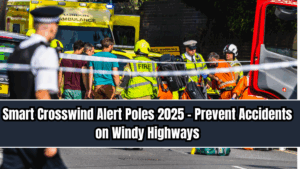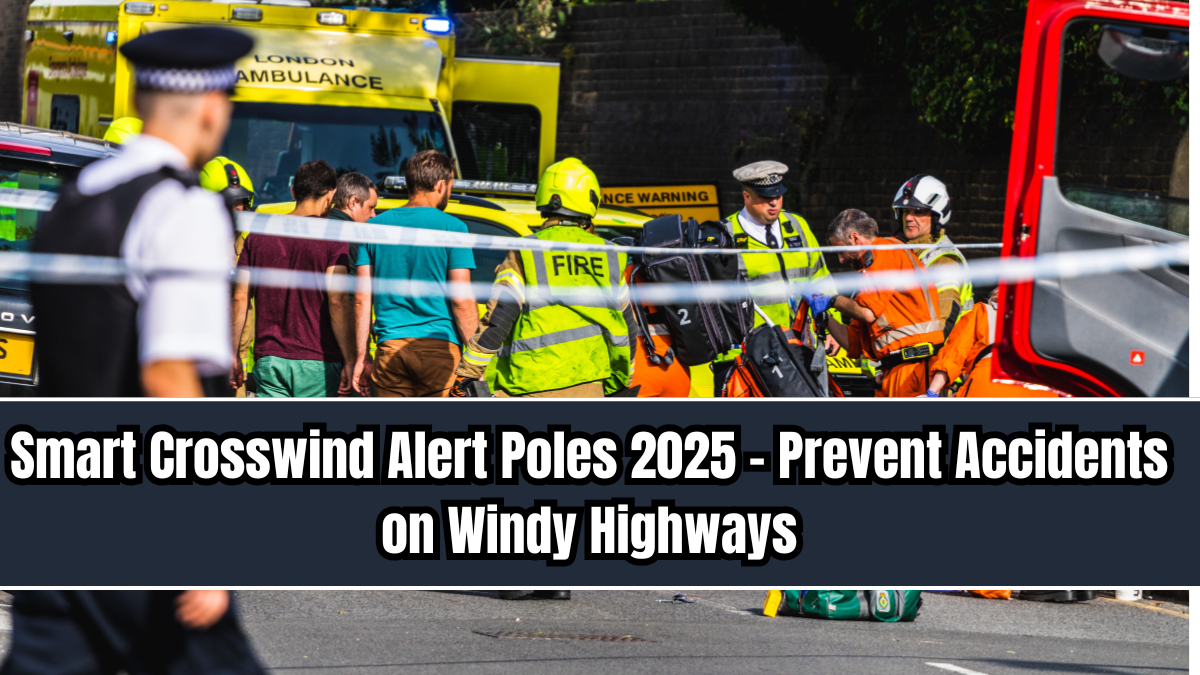Driving on highways is thrilling, but it also comes with risks—especially when unexpected crosswinds hit vehicles at high speeds. In 2025, India is addressing this often-overlooked hazard with the launch of Smart Crosswind Alert Poles, a first-of-its-kind road safety initiative that combines sensors, AI technology, and real-time alerts to protect drivers.
By installing these poles along wind-prone stretches of highways, the government is introducing a much-needed safety net that can drastically reduce accidents caused by sudden wind shifts.

The Need for Crosswind Alerts
Crosswinds are lateral gusts of wind that hit vehicles from the side, especially dangerous for:
-
Trucks and buses, which have large surfaces prone to wind drag.
-
Two-wheelers, where stability can be easily compromised.
-
Passenger cars overtaking at high speeds.
On highways and elevated bridges, strong crosswinds can cause vehicles to swerve, skid, or even overturn. Until now, Indian highways had little infrastructure to warn drivers about such risks. The Crosswind Alert Poles 2025 change that by providing real-time warnings before vehicles enter danger zones.
How the Smart Poles Work
The poles are equipped with advanced wind sensors, radar systems, and AI processors. They function in three stages:
-
Detection – Sensors measure wind speed, direction, and turbulence in real-time.
-
Analysis – AI algorithms determine whether conditions are dangerous for vehicles.
-
Alert – If risky winds are detected, poles light up with visual signals, while roadside boards and in-car connected systems issue warnings.
Drivers see LED alerts, speed-limit indicators, or caution symbols flashing ahead, giving them enough time to slow down and stabilize their vehicles.
Pilot Locations in 2025
The project has begun in wind-prone stretches of Rajasthan, Gujarat, and coastal highways. Elevated flyovers in Mumbai and Chennai are also equipped with these smart poles, as crosswinds are particularly strong in these regions.
The success of these pilots will determine expansion to other vulnerable areas across India’s national highway network.
Benefits for Road Safety
The Smart Crosswind Alert Poles are expected to significantly improve road safety by:
-
Reducing accidents caused by sudden wind gusts.
-
Protecting vulnerable vehicles like trucks, buses, and two-wheelers.
-
Improving traffic flow, as drivers get early warnings and can adjust safely.
-
Raising awareness of crosswind dangers, which are often underestimated.
International studies show that timely crosswind warnings can cut accident risks by up to 40%, and India hopes to achieve similar results.
Technology and AI Integration
The poles are part of India’s growing smart highway ecosystem. Integrated with IoT networks and AI platforms, they can communicate with:
-
Smart traffic lights for automated speed control.
-
Connected vehicle systems, sending alerts directly to car dashboards.
-
Central monitoring centers, where highway authorities track weather and safety conditions.
This integration ensures a seamless safety net that goes beyond static signage.
Supporting India’s Smart Infrastructure Goals
The Crosswind Alert Poles 2025 are aligned with India’s vision for intelligent transport systems (ITS). Alongside smart tolling, real-time traffic updates, and EV charging infrastructure, these poles demonstrate how highways are evolving into digital safety corridors.
They also support India’s road safety mission, which aims to reduce accidents and fatalities by half by the end of the decade.
Challenges and Considerations
Despite their promise, the initiative faces challenges:
-
High installation costs for sensors and AI integration.
-
Maintenance needs in remote and harsh weather zones.
-
Driver education, since many motorists are unfamiliar with crosswind hazards.
To tackle this, the government is running awareness campaigns through highway ads, FM radio, and digital platforms, ensuring that drivers understand what the alerts mean.
Looking Ahead
If the pilot proves successful, India plans to install thousands of smart poles across coastal highways, mountain passes, and desert stretches. Future upgrades may include:
-
Solar-powered poles to reduce energy costs.
-
Voice-based alerts for connected vehicles.
-
AI weather forecasting, predicting wind risks hours in advance.
By 2030, the vision is to make smart safety infrastructure standard across all major highways.
Final Thoughts
The Smart Crosswind Alert Poles 2025 show how simple innovations powered by AI can save lives. By addressing a critical but often overlooked risk, India is making its highways safer, smarter, and more future-ready.
For drivers, these poles mean greater confidence on long trips. For policymakers, they reflect progress toward sustainable road safety. And for the nation, they prove that technology and infrastructure can work hand in hand to protect lives.
FAQs
What are Smart Crosswind Alert Poles 2025?
They are sensor-equipped poles installed on highways that detect dangerous crosswinds and warn drivers in real-time.
Where are these poles installed?
Pilot installations have started in Rajasthan, Gujarat, coastal highways, and elevated flyovers in Mumbai and Chennai.
How do the poles alert drivers?
They use LED lights, digital boards, and connected vehicle systems to issue warnings when crosswinds are detected.
Why are crosswinds dangerous?
They can cause vehicles—especially trucks, buses, and two-wheelers—to swerve, skid, or overturn unexpectedly.
How do these poles use AI?
AI analyzes wind data in real-time, determines risks, and triggers alerts to ensure timely driver response.
Do they work in all weather conditions?
Yes, they are designed to function in extreme heat, dust, rain, and coastal wind zones.
Will the system expand nationwide?
Yes, the government plans to extend installations across other wind-prone regions, including mountain passes and desert highways.
Click here to know more.
